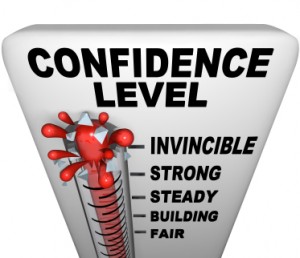 Recently, I had the honor to be an audience member instead of a presenter. By watching instead of doing, I got the opportunity to re-assess my beliefs about what makes speakers effective. Here’s what I noticed:
Recently, I had the honor to be an audience member instead of a presenter. By watching instead of doing, I got the opportunity to re-assess my beliefs about what makes speakers effective. Here’s what I noticed:
5 Ways Speakers Sabotage Themselves
Mechanistic Movement
I’ll be honest here. I’ve only noticed a case of “robot-arms” this extreme a few times in the 20 years of my professional career. Every time one speaker said a certain word, he self-consciously drew a shape in the air with his hands. I counted five of these word-and-gesture-pairings. The effect was of an overly rehearsed, stilted high school actor.
Tornado Talking
Several presenters’ speed-talking, punctuated with very few pauses, led to audience exhaustion. Women presenters were the biggest offenders.
Big Chest in a Tight Blouse (I couldn’t think of how to use alliteration here)
The audience could see the lines of one presenter’s underclothes, and even what lie beneath them. Additionally, this speaker dressed more casually than most of her audience. (Do remember the rule: “Dress like your audience, but one step better.” )
Boring Bearing
Wearing sparkly clothes didn’t make up for one speaker’s inward-turned shoulders and powerless posture. (To learn about the Power Posture watch this great video: http://www.ted.com/talks/amy_cuddy_your_body_language_shapes_who_you_are.html)
Egregious Embellishment
Several presenters used lots and lots of very, very, absolutely, incredible, awesome, unbelievable, excellent, top-of-the-line adjectives. It was as if these speakers didn’t believe the truth of their messages, so tried to pump them up to make us believe. The opposite occurred.
3 Ways Speakers Increase Their Credibility
I’m probably the audience member from hell because of my merciless observations. However, I wouldn’t want to imply that I didn’t see anything that worked. Here are three behaviors that added to the authority and credibility of several speakers.
Purposeful Perambulation
The (female) speaker moved toward the audience, then stopped when delivering important messages. She refrained from:
- Pacing
- Walking backward
- Shifting her weight from side to side
- Talking while walking
- Standing like a cheerleader: (weight on one hip).
She always included the entire audience with her body position, not just with her eye contact. As a result, her words were compelling.
Enthusiasm Embodied
The best presenters appeared to be enjoying themselves. They displayed passion about their subjects. Their voices were both deliberate and naturally excited. They gestured authentically to emphasize their messages. (For the best article I’ve found on exuding enthusiasm as a speaker, see: https://gm.wp.zi3.xyz/training-development/the-joy-of-training/).
Audience Advocacy
This term, coined by Jerry Weissman, simply means that the speaker continually let us know how his information would benefit us. Sprinkled throughout his presentation, he asked questions like:
“Now, why is this important?”
“Why should YOU care?” and
“Why am I telling you this?”—and proceed to answer in ways that made it clear how his information was in OUR (the audience’s) best interest.
Potent Presenting
When you lose the first five behaviors listed above, you’ll stop asking yourself, “Now, why didn’t that work like I thought it would?” By integrating the last three points, your public speaking becomes more compelling, dynamic and powerful. Enjoy!
Want more tips to improve your speaking self? Learn about Guila Muir’s Presentation Skills Workshop.
Guila Muir is a premiere trainer of trainers, facilitators, and presenters. Since 1994, she has helped thousands of professionals improve their training, facilitation, and presentation skills. Find out how she can help transform you into a great presenter: www.guilamuir.com


 My grandma was “word-clever” almost until the day she died. I especially remember her corny puns and plays on words, which made me both laugh and groan. Researchers Alan Seidman, of Johnson and Wales University, and Stephen C. Brown, of the University of Alaska, say “Puns are a humorous way to get adult learners to think more critically about any subject.”
My grandma was “word-clever” almost until the day she died. I especially remember her corny puns and plays on words, which made me both laugh and groan. Researchers Alan Seidman, of Johnson and Wales University, and Stephen C. Brown, of the University of Alaska, say “Puns are a humorous way to get adult learners to think more critically about any subject.”


 Recently, I had the honor to be an audience member instead of a presenter. By watching instead of doing, I got the opportunity to re-assess my beliefs about what makes speakers effective. Here’s what I noticed:
Recently, I had the honor to be an audience member instead of a presenter. By watching instead of doing, I got the opportunity to re-assess my beliefs about what makes speakers effective. Here’s what I noticed: Great trainers must be great presenters as well. I believe that participants learn most from highly active classes that imbed great design and content. However, I also know that the trainer’s presentation skills can help or hinder learning.
Great trainers must be great presenters as well. I believe that participants learn most from highly active classes that imbed great design and content. However, I also know that the trainer’s presentation skills can help or hinder learning.

 Oh, if only I could advocate Figleaf, since it’s the go-to position of many presenters. After giving Figleaf a thumbs-up in this fantasy scenario, I could also wholeheartedly endorse the following, both online and IRL:
Oh, if only I could advocate Figleaf, since it’s the go-to position of many presenters. After giving Figleaf a thumbs-up in this fantasy scenario, I could also wholeheartedly endorse the following, both online and IRL: Figleaf occurs when you place one or more hands in front of your midsection or abdomen. Using “Figleaf”, even while sitting, closes you in and hunches you inward. It can lower others’ perception of your credibility.
Figleaf occurs when you place one or more hands in front of your midsection or abdomen. Using “Figleaf”, even while sitting, closes you in and hunches you inward. It can lower others’ perception of your credibility.